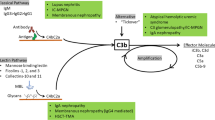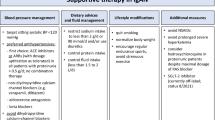Abstract
Background
To elucidate the role of mast cells (MCs) in the pathogenesis of tubulointerstitial lesions in IgA nephropathy (IgAN), we investigated the number of MCs, serum stem cell factor (SCF), protease-activated receptor-2 (PAR-2) and α-smooth-muscle actin (α-SMA) in the kidney and the correlation between MC number, SCF, PAR-2, α-SMA and tubulointerstitial lesions in biopsy specimens and serum creatinine levels, urinary protein excretion in patients with IgA nephropathy.
Methods
Thirty-five patients with IgA nephropathy were enrolled in this study. Clinical parameters, such as serum creatinine and urinary protein excretion, were obtained from each patient at the time of biopsy. Paraffin-embedded sections were used for immunohistochemical staining. Monoclonal antibodies to human tryptase, α-SMA, and SCF and polyclonal antibody to PAR-2 were used as primary antibodies. Ten cortical interstitial fields were randomly selected and assessed using a computer-assisted color image analyzer. Tubulointerstitial fibrosis was assessed as the percentage of the area stained with Masson trichrome in ten cortical interstitial fields.
Results
In all of the control subjects, few tryptase-positive MCs were observed in the glomeruli and interstitium. In contrast, sparse MCs were observed in the interstitium, but not in the glomeruli of diseased kidneys. The number of interstitial MCs in the tubulointerstitial lesions, the expression of SCF, PAR-2 and α-SMA were positively correlated with the degree of interstitial fibrosis. A close correlation between MCs, α-SMA, PAR-2 and SCF was found (r = 0.887 for α-SMA, r = 0.844 for PAR-2, r = 0.853 for SCF, P < 0.01). Also a close correlation between α-SMA, PAR-2 and SCF was found (r = 0.874 for PAR-2, r = 0.862 for SCF, P < 0.01). PAR-2 was correlated with SCF (r = 0.893, P < 0.01). Moreover, a significant positive correlation was observed between the number of interstitial MCs, the expression of SCF, PAR-2 and α-SMA and the serum creatinine level (r = 0.738 for MCs, r = 0.658 for α-SMA, r = 0.692 for PAR-2, r = 0.754 for SCF, P < 0.05).
Conclusions
Our findings suggest that MC infiltration possibly induced by SCF in renal interstitial tissues seems to be associated with tubulointerstitial fibrosis through PAR-2 in IgA nephropathy.








Similar content being viewed by others
References
Berger J, Hinglais N. Intercapillary deposits of IgA–IgG. J Urol Nephrol (Paris). 1968;74:694–5.
D’Amico G. The commonest glomerulonephritis in the world: IgA nephropathy. Q J Med. 1987;64:709–27.
Coppo R, D’Amico G. Factors predicting progression of IgA nephropathies. J Nephrol. 2005;18:503–12.
Cameron JS. Tubular and interstitial factors in the progression of glomerulonephritis. Pediatr Nephrol. 1992;6:292–303.
Nath KA. Tubulointerstitial changes as a major determinant in the progression of renal damage. Am J Kidney Dis. 1992;20:1–17.
Eddy AA. Molecular insights into renal interstitial fibrosis. J Am Soc Nephrol. 1996;7:2495–508.
Abe S, Amagasaki Y, Iyori S, Konishi K, Kato E, Sakaguchi H. Significance of tubulointerstitial lesions in biopsy specimens of glomerulonephritis patients. Am J Nephrol. 1989;9:30–7.
Roberts ISD, Burrows C, Shanks JH, et al. Interstitial myofibroblasts: predictors of progression in membranous nephropathy. J Clin Pathol. 1997;50:123–7.
Alexopoulos E, Seron D, Hartley RB, et al. Immune mechanisms in idiopathic membranous nephropathy: the role of interstitial infiltrates. Am J Kidney Dis. 1989;13:404–12.
Bohle A, Muller GA, Wehrmann M, et al. Pathogenesis of chronic renal failure in the primary glomerulopathies, renal vasculopathies and chronic interstitial nephritides. Kidney Int. 1996;49:S2–9.
Alpers CE, Hudkins KL, Floege J, et al. Human renal cortical interstitial cells with some features of smooth muscle cells participate in tubulointerstitial and crescentic injury. J Am Soc Nephrol. 1994;5:201–10.
Rother MJ, Nowak M, Kerdel FA, et al. The mast cell in health and disease. J Am Acid Dermatol. 1990;23:615–24.
Schulman ES. The role of mast cells in inflammatory reponses in the lung. Crit Rev Immunol. 131:35–70.
Craig SS, Deblois G, Schwartz LB. Mast cells in human keloid, small intestine, and lung by an immunoperoxidase technique using a murine monoclonal antibody against tryptase. Am J Pathol. 1986;124:428–35.
Ehara T, Shigematsu H. Contribution of mast cells to the tubulointerstitial lesions in IgA nephritis. Kidney Int. 1998;54:1675–83.
Hiromura K, Kurosawa M, Yano S, Naruse T. Tubulointerstitial mast cell infiltration in glomerulonephritis. Am J Kidney Dis. 1998;32:593–9.
Roberts IS, Brenchley PE. Mast cells: the forgotten cells of renal fibrosis. J Clin Pathol. 2000;53:858–62.
Toth T, Toth-Jakatics R, Jimi S, Ihara M, Urata H, Takebayashi S. Mast cells in rapidly progressive glomerulonephritis. J Am Soc Nephrol. 1999;10:1498–505.
Galli SJ. New insights into “the riddle of the mast cells”: microenvironmental regulation of mast cell development and phenotypic heterogeneity. Lab Invest. 1990;62:5–33.
Brito JM, Borojevic R. Liver granulomas in schistosomiasis: mast cell dependent induction of SCF expression in hepatic stellate cells is mediated by TNF-α. J Leukoc Biol. 1997;62:389–95.
Valent P. The riddle of the mast cell: Kit (cd117) ligand as the missing link. Immunol Today. 1994;15:111–4.
Nilsson G, Butterfield JH, Nilsson K, Siegbaha A. Stem cell factor is chemotactic for human mast cells. J Immunol. 1994;1533:3718–23.
Metcalfe DD, Baram D, Mekori YA. Physiol. Physiol Rev. 1997;77:1033–79.
Ruoss SJ, Hartmann T, Caughey GH. J Clin Invest. 1991;88:493–9.
Woodbury RG, Everitt MT, Neurath H. Methods Enzymol. 1981;80:588–609.
Akers IA, Parsons M, Hill MR, Hollenberg MD, Sanjar S, Laurent GJ, et al. Am J Physiol. 2000;278:L193–201.
Gruber BL, Kew RR, Jelaska A, Marchese MJ, Garlick J, Ren S, et al. J Immunol. 1997;158:2310–7.
Corvera CU, Dery O, McConalogue K, Bohm SK, Khitin LM, Caughey GH, et al. Mast cell tryptase regulates rat colonic myocytes through proteinase-activated receptor 2. J Clin Invest. 1997;100:1383–93.
Steinhoff M, Corvera CU, Thoma MS, Kong W, McAlpine BE, Caughey GH, et al. Proteinase-activated receptor-2 in human skin: tissue distribution and activation of keratinocytes by mast cell tryptase. Exp Dermatol. 1999;8:282–94.
Schechter NM, Brass LF, Lavker RM, Jensen PJ. Reaction of mast cell proteases tryptase and chymase with protease activated receptors (PARs) on keratinocytes and fibroblasts. J Cell Physiol. 1998;176:365–73.
Kawabata A. PAR-2: structure, function and relevance to human diseases of the gastric mucosa. Expert Rev Mol Med. 2002;16:1–17.
Frungieri MB, Weidinger S, Meineke V, Ko¨hn FM, Mayerhofer A. Proliferative action of mast-cell tryptase is mediated by PAR-2, COX2, prostaglandins, and PPAR-γ: possible relevance to human fibrotic disorders. Proc Natl Acad Sci USA. 2002;99:15072–7.
Lajoie G, Nadasdy T, Laszik Z, Blick KE, Silva FG. Mast cells in acute cellular rejection of human renal allografts. Mod Pathol. 1996;9:1118–25.
Hunt LW, Colby TV, Weiler DA, Sur S, Butterfield JH. Immunofluorescent staining for mast cells in idiopathic pulmonary fibrosis: quantification and evidence for extracellular release of mast cell tryptase. Mayo Clin Proc. 1992;67:941–8.
Kakizoe E, Shiota N, Tanabe Y, Shimoura K, Kobayashi Y, Okunishi H. Isoform-selective upregulation of mast cell chymase in the development of skin fibrosis in scleroderma model mice. J Invest Dermatol. 2001;116:118–23.
Bradding P, Feather LH, Wilson S, et al. Immunolocalization of cytokines in the nasal mucosa of normal and perineurial rhinitic subjects: the mast cell as a source of IL-4, IL-5, and IL-6 in human allergic mucosal inflammation. J Immunol. 1993;151:3853–65.
Qu Z, Lieblex JM, Poevers MR, et al. Mast cells are a major source of basic fibroblast growth factor in chronic inflammation and cutaneous hemangioma. Am J Pathol. 1995;147:564–73.
Hatamochi A, Fujiwara K, Veki H. Effects of histamine on collagen synthesis by cultured fibroblasts derived from guinea pig skin. Arch Dermatol Res. 1985;277:60–4.
Ruoss SJ, Hartmann T, Caughey GH. Mast cell tryptase is a mitogen for cultured fibroblasts. J Clin Invest. 1991;88:493–9.
Desmouliere A, Geinoz A, Gabbiani F, Gabbiani G. Transforming growth factor β1 induces α-smooth muscle actin expression in granulation tissue myofibroblasts and in quiescent and growing fibroblasts. J Clin Biol. 1993;122:1103–11.
Valent P, Spanblochl E, Sperr WR, Sillaber C, Zsebo KM, Agis H, et al. Induction of differentiation of human mast cells from bone marrow and peripheral blood mononuclear cells by recombinant human stem cell factor/kit-ligand in long-term culture. Blood. 1992;80:2237–45.
Columbo M, Horowitz EM, Botana LM, McGlashan DW Jr, Bochner BS, Gillis S, et al. The human recombinant c-kit receptor ligand, rhSCF, induces mediator release from human cutaneous mast cells and enhances IgE-dependent mediator release from both skin mast cells and peripheral blood basophils. J Immunol. 1992;149:599–608.
Hogaboam C, Kunkel SL, Strieter RM, Taub DD, Lincoln P, Strandiford TJ, et al. Novel role of transmembrane SCF for mast cell activation and eotaxin production in mast cell fibroblast interactions. J Immunol. 1998;160:6166–71.
El-Koraie AF, Baddour NM, Adam AG, El Kashef EH, El Nahas AM. Role of stem cell factor and mast cells in the progression of chronic glomerulonephritides. Kidney Int. 2001;60:167–72.
Galli SJ. New concepts about the mast cell. N Engl J Med. 1993;328:257–65.
Brown JK, Tyler CL, Jones CA, Ruoss SJ, Hartmann T, Caughey GH. Tryptase, the dominant secretary granular protein in human mast cells, is a potent mitogen for cultured dog tracheal smooth muscle cells. Am J Respir Cell Mol Biol. 1995;13:227–36.
Cairns JA, Walls AF. Mast cell tryptase is a mitogen for epithelial cells: stimulation of IL-8 production and intercellular adhesion molecule-1 expression. J Immunol. 1996;156:257–83.
Dery O, Corvera CU, Steinhoff M, Bunnett NW. Proteinase activated receptors: novel mechanisms of signaling by serine proteases. Am J Physiol. 1998;274:C1429–52.
Nystedt S, Emilsson K, Wahlestedt C, Sundelin J. Molecular cloning of a potential proteinase activated receptor. Proc Natl Acad Sci USA. 1994;91:9208–12.
Molino M, Woolkalis MJ, Reavey-Cantwell J, Pratico D, Andrade-Gordon P, Barnathan ES, et al. Endothelial cell thrombin receptors and PAR-2: two protease-activated receptors located in a single cellular environment. J Biol Chem. 1997;272:11133–341.
Nystedt S, Ramakrishnan V, Sundelin J. The proteinase-activated receptor 2 is induced by inflammatory mediators in human endothelial cells: comparison with the thrombin receptor. J Biol Chem. 1996;271:14910–5.
Mirza H, Yatsula V, Bahou WF. The proteinase activated receptor-2 (PAR-2) mediates mitogenic responses in human vascular endothelial cells. J Clin Invest. 1996;97:1705–14.
Bono F, Lamarche I, Herbert JM. Induction of vascular smooth muscle cell growth by selective activation of the proteinase activated receptor-2 (PAR-2). Biochem Biophys Res Commun. 1997;241:762–4.
Molino M, Raghunath PN, Kuo A, Ahuja M, Hoxie JA, Brass LF. Barnathan ES: differential expression of functional protease activated receptor-2 (PAR-2) in human vascular smooth muscle cells. Arterioscler Thromb Vasc Biol. 1998;18(5):825–32.
Cicala C, Morello S, Santagada V, Caliendo G, Sorrentino L, Cirino G. Pharmacological dissection of vascular effects caused by activation of protease-activated receptors 1 and 2 in anesthetized rats. FASEB J. 2001;15:1433–5.
Kawabata A, Kuroda R, Nakaya Y, Kawai K, Nishikawa H, Kawao N. Factor Xa-evoked relaxation in rat aorta: involvement of PAR-2. Biochem Biophys Res Commun. 2001;282:432–5.
Cairns JA, Walls AF. Mast cell tryptase stimulates the synthesis of type I collagen in human lung fibroblasts. J Clin Invest. 1997;99:1313–21.
Desmouliere A, Rubbia-Brandt L, Grau G, Gabbiani G. Heparin induces alpha-smooth muscle actin expression in cultured fibroblasts and in granulation tissue myofibroblasts. Lab Invest. 1992;67:716–26.
Ruger BM, Hasan Q, Greenhill NS, Davis PF, Dunbar PR, Neale TJ. Mast cells and type VIII collagen in human diabetic nephropathy. Diabetologia. 1996;39:1215–22.
Chihara Y, Ono H, Ishimitsu T, Ono Y, Ishikawa K, Rakugi H, et al. Roles of TGF-beta1 and apoptosis in the progression of glomerulosclerosis in human IgA nephropathy. Clin Nephrol. 2006;65:385–92.
Ranieri E, Gesualdo L, Grandaliano G, Maiorano E, Schena FP. The role of alpha-smooth muscle actin and platelet derived growth factor-beta receptor in the progression of renal damage in human IgA nephropathy. J Nephrol. 2001;14:253–62.
Hiromura K, Kurosawa M, Yano S, Naruse T. Tubulointerstitial mast cell infiltration in glomerulonephritis. Am J Kidney Dis. 1998;32:593–9.
Author information
Authors and Affiliations
Corresponding author
Additional information
Responsible Editor: A. Falus.
Y. Peng and H. Liu equally contributed to this work.
Rights and permissions
About this article
Cite this article
Liu, H., Liu, F., Peng, Y. et al. Role of mast cells, stem cell factor and protease-activated receptor-2 in tubulointerstitial lesions in IgA nephropathy. Inflamm. Res. 59, 551–559 (2010). https://doi.org/10.1007/s00011-010-0159-7
Received:
Accepted:
Published:
Issue Date:
DOI: https://doi.org/10.1007/s00011-010-0159-7




